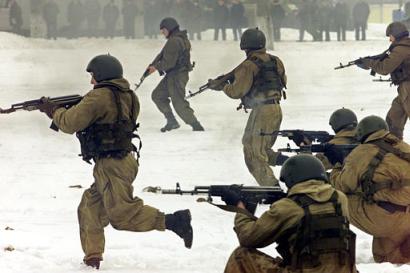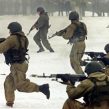
Bat or Mouse? The Strange Case of Reforming Spetsnaz
Publication: Eurasia Daily Monitor Volume: 7 Issue: 198
By:

One distinguishing hallmark of Russian defense reform is the unpredictable and apparently indiscriminate manner in which it is implemented. This approach leaves officers wondering about their future and where the next “surprise” might surface. The latest “victim” in this unstoppable process was the GRU Spetsnaz (Glavnoye Razvedyvatel’noye Upravleniye –GRU, Voyska spetsialnogo naznacheniya –Spetsnaz); the prestigious Special Forces under the General Staff’s military intelligence directorate. Marking its 60th anniversary on October 24, on Spetsnaz Day, the defense ministry announced that the GRU Spetsnaz is now subordinate to the operational-strategic commands, in other words it has been transferred from the General Staff to the ground forces. Lieutenant-Colonel Sergei Vlasov, a defense ministry spokesman, told Interfax “As the armed forces are being reformed, Spetsnaz separate brigades are attached to the army and directly subordinated to commanders of combined strategic commands” (Interfax, October 25).
A report on the defense ministry controlled Zvezda TV, on October 22, showed a Spetsnaz brigade on exercise in Samara Region, but made no mention of any impending reform. Media coverage critical of the decision to move the GRU Spetsnaz to the army noted that Defense Minister, Anatoliy Serdyukov, had not issued the traditional order to recognize the annual special day, nor did he or other senior defense officials, such as the Chief of the General Staff, Army-General Nikolai Makarov, or the Commander-in-Chief of the Ground Forces, Colonel-General Aleksandr Postnikov, attend any officially related events marking the celebrations. ITAR-TASS noted almost in passing that the structural change had occurred, identifying Spetsnaz as being subordinate to the ground forces and quoted Deputy Chief of Staff for Reconnaissance, Colonel Vladimir Mardusin, who confirmed switching the Special Forces to the military district/operational-strategic commands (Zvezda TV, October 22; www.stoletiye.ru, October 25; ITAR-TASS, October 24).
Rossiyskaya Gazeta correspondent, Sergey Ptichkin, suggested that professional Spetsnaz officers were furious about the latest twist in the reform, believing it is simply impossible to train Spetsnaz reconnaissance/saboteurs in the context of the twelve months term of conscript service. Numerous concerns were triggered by the structural reform of Spetsnaz, including whether parachute training might be abolished and how in the future their training standards will be maintained. Ptichkin, reflecting the anger among retired GRU and Spetsnaz officers, said “There is still the symbol of military reconnaissance –the bat. But very soon it will be possible to boldly replace this silent night hunter on the emblem with a grey field mouse: a sweet and inoffensive ground-pounder” (www.stoletiye.ru, October 25).
Dmitriy Litovkin, in an article in Izvestiya in November 2009, forecast the subordination of Spetsnaz to the ground forces. Noting that the 3rd, 12th and 67th Spetsnaz brigades were disbanded and highlighting the risk that the 16th Spetsnaz brigade might face a similar fate Litovkin and Igor Korotchenko linked the possible movement of Spetsnaz units to the control of military district commanders with the poor performance of the GRU and Spetsnaz in the Russia-Georgia war in August 2008 (Izvestiya, November 6, 2009). Reforming Spetsnaz apparently arose from the lessons learned from the operational failings during that conflict, and in the context of the current defense reform it appears to make sense to place these assets at the disposal of the ground forces. Ptichkin’s emotionally charged defense of the traditional organizational structure of Spetsnaz included the assertion that Spetsnaz had prevented the Georgian army sabotaging the Rokki tunnel in August 2008, though he conveniently bypassed the culpability of the GRU in the blatant intelligence failings that resulted in the Russian air force bombing disused Georgian airfields during the conflict.
In a similar manner, compared with how other features of the reform process were suddenly announced and hurriedly implemented, there was no effort to explain or justify the Spetsnaz initiative: particularly among its key constituency –serving officers. The critique of the latest initiative is also rooted in opposition from retired officers (since serving officers are not permitted to oppose the reform) that focuses on the assertion that Serdyukov is destroying the army. What is obvious is that the “new look” itself is changing and evolving, consistent with no grand plan existing, as well as recognizing problems encountered along the path of reform. Consequently, the fear that the GRU “bat” might be reduced to a grey field mouse is as basic and extreme as Colonel (retired) Anatoliy Tsyganok posing the question as to whether the “new look” is in fact merely “plastic surgery” (Vremya Novostey, December 3, 2009). Many of the reform innovations are not only misunderstood by its critics, but even the reformers themselves admit they cannot fully appreciate their long term implications.
Indeed, this strange case of apparently belatedly reforming the GRU Spetsnaz not only confirms an appetite among the reformers to act upon the lessons learned from the Georgian campaign, but that “lessons” or reform models may be drawn from numerous sources, not least reflecting on some of the mistakes made during the reform. Briefing a closed Duma defense committee in late October, General Makarov appeared to step back from planning to hold as many operational-strategic exercises in future: since the reform began, Kavkaz, Lagoda, Zapad 2009 and Vostok 2010 have revealed numerous flaws. Moreover, Makarov has understood that the professional standards and training of officers is inadequate, and staging such intensive exercises is counter-productive as commanders in turn spend too much time preparing their forces for the specific tasks demanded by a major exercise. In 2011, only one operational-strategic exercise will take place, Tsentr 2011, allowing more time to be devoted to reworking the methodology of soldiers’ training, individual training and subunit combat teamwork, as well as training the trainers: platoon, company, and battalion and brigade commanders. That approach, jettisoning the traditional shows for the generals, will facilitate real improvements to combat training and may defuse geopolitical tensions stemming from other countries misinterpreting the “signals” conveyed by large-scale maneuvers (Nezavisimoye Voyennoye Obozreniye, October 29).
An organizational transformation does not signify deeper systemic reform, and the change to the Spetsnaz may prove less disruptive than its critics fear. However, such innovations are more than simply shuffling the deck of cards, as it illustrates that the reformers have cart blanche to make any changes they deem fit. Moreover, it raises anxieties within the military as to which elements will appear in the cross hairs of the reform: will the GRU or even the General Staff become future targets?




